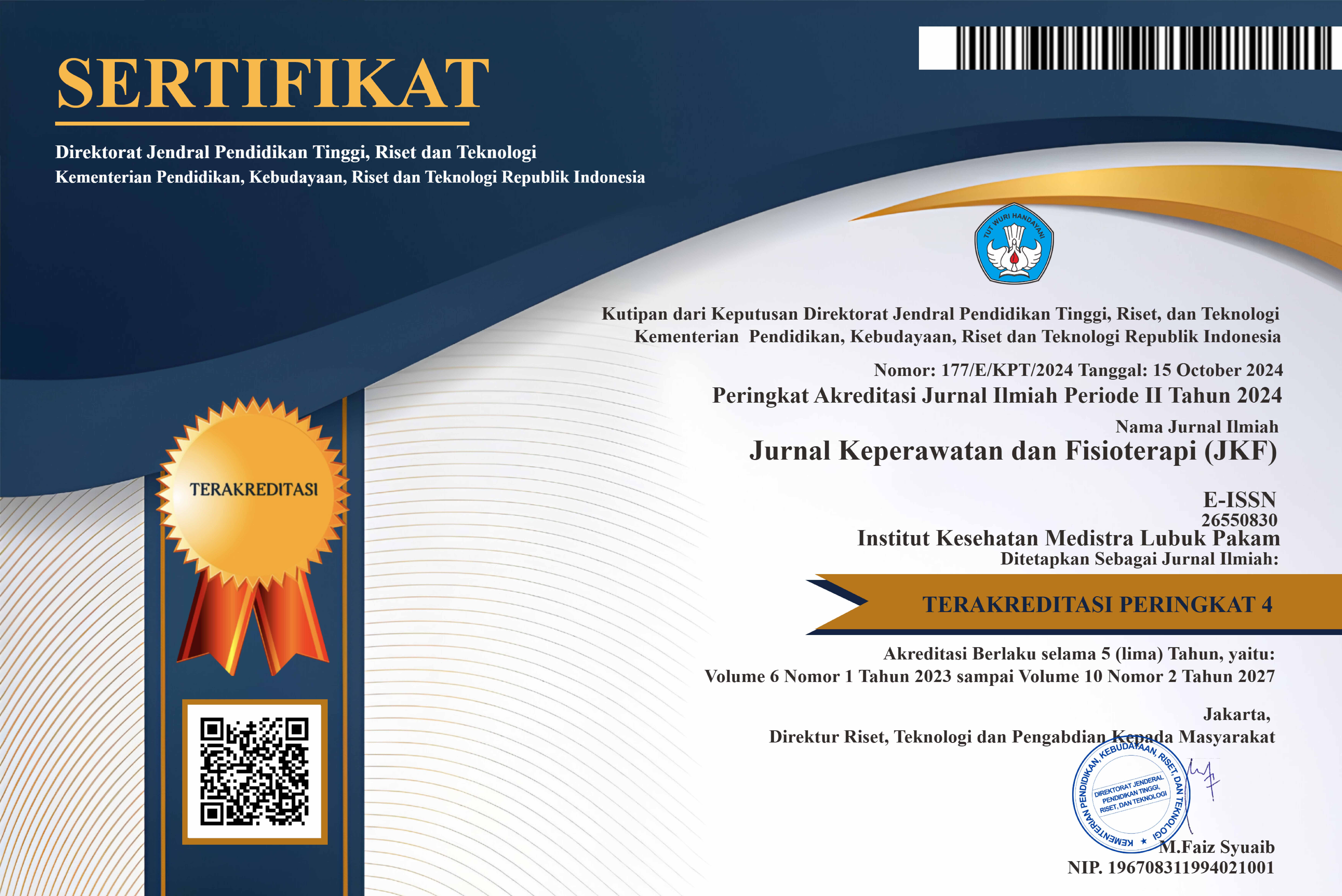Overhead Chop Exercise and Double Leg Balance Exercise on Postural Control Children With Autism Spectrum Disorder
DOI:
https://doi.org/10.35451/jkf.v6i2.1918Keywords:
Overhead chop exercise, double leg balance exercise, Autisme, postural controlAbstract
This study aims to description of overhead chop exercises and double leg balance exercises in improving postural control to children with autism spectrum disorder (ASD). Method: This research is a qualitative descriptive research with a case study approach, type of action research. The samples were child patients who underwent therapy at the YCHI Autism Center clinic, South Tangerang. Overhead chop training provides an illustration of improving postural control in the sample. The sample is directed to receive proprioceptive stimulation which is then carried to the brain so that it can maintain an upright position and not fall. The double leg balance exercise also provides an illustration of improving postovertural control. The sample provides instructions for performing lift and chop movements. This movement forms a diagonal movement pattern which can help to rotate the trunk diagonally and stretch the thorax and pelvis. Overhead chop exercises and double leg balance exercises can provide overview of postural control in children with ASD.
Downloads
References
Assyakurrohim, Ikhram , Sirodj, et al. 2023."Metode Studi Kasus dalam Penelitian Kualitatif." Jurnal Pendidikan Sains dan Komputer, vol 3, no. 1.
Augustyn, Gelora Helena, et al. .2017.“Pengaruh Penambahan Tepung Daun Kelor (Moringa Oleifera) Terhadap Karakteristik Organoleptik Dan Kimia Biskuit Mocaf (Modifie Cassava Flour).”Jurnal Teknologi Pertanian, vol. 6, no. 2, pp. 52 58.
Bell, David R., Kevin M. Guskiewicz, Micheal A. Clark, and Darin A. Padua. 2011. “Systematic Review of the Balance Error Scoring System.” Sports Health 3 (3): 287–95.
Cheldavy, Hakim, Saeid Shakerian, Seyedeh Nahid Shetab Boshehri, and Mehdi Zarghami. 2016. “The Effects of Balance Training Intervention on Postural Control of Children with Autism Spectrum Disorder: Role of Sensory Information.” Research in Autism Spectrum Disorders 8 (1): 8–14.
Chen, Fu Chen, Chia Liang Tsai, Wen Dien Chang, Yao Chuen Li, Chun Liang Chou, and Sheng Kuang Wu. 2015. “Postural Control of Anteroposterior and Mediolateral Sway in Children with Probable Developmental Coordination Disorder.” Pediatric Physical Therapy 27 (4): 328–35.
Doumas, Michail, Roisin McKenna, and Blain Murphy. 2016. “Postural Control Deficits in Autism Spectrum Disorder: The Role of Sensory Integration.” Journal of Autism and Developmental Disorders 46 (3): 853–61.
Elfath, Orisa, and Anggita, Miranti Yolanda. 2019. “Penambahan Catching Ball Exercisepada Balance Board Exercise Terhadap Peningkatan Postural Control Pada Anak Dengan.” Autis Jurnal Fisioterapi. Vol. 19.
Gadad, Bharathi S., Laura Hewitson, Keith A. Young, and Dwight C. German. 2013. “Neuropathology and Animal Models of Autism: Genetic and Environmental Factors.” Autism Research and Treatment 2013: 1–12.
Ha, Sungji, In-Jung Sohn, Namwook Kim, Hyeon Jeong Sim, and Keun-Ah Cheon. 2015. “Characteristics of Brains in Autism Spectrum Disorder: Structure, Function and Connectivity across the Lifespan.” Experimental Neurobiology 24 (4): 273–84.
Hannant, Penelope, Teresa Tavassoli, and Sarah Cassidy. 2016. “The Role of Sensorimotor Difficulties in Autism Spectrum Conditions.” Frontiers in Neurology 7 (AUG): 1–11.
Hansen, Colby, Dan Cushman, Nicholas Anderson, Wei Chen, Christine Cheng, Shirley D. Hon, and Man Hung. 2016. “A Normative Dataset of the Balance Error Scoring System in Children Aged between 5 and 14.” Clinical Journal of Sport Medicine 26 (6): 497–501.
Hsu, Shih-Lin, et al. 2018. "Effects of core strength training on core stability." The Journal of Physical Therapy Science.
King, Laurie A., Fay B. Horak, Martina Mancini, Donald Pierce, Kelsey C. Priest, James Chesnutt, Patrick Sullivan, and Julie C. Chapman. 2014. “Instrumenting the Balance Error Scoring System for Use with Patients Reporting Persistent Balance Problems after Mild Traumatic Brain Injury.” Archives of Physical Medicine and Rehabilitation 95 (2): 353–59.
Morgan, John T., Nicole Barger, David G. Amaral, and Cynthia M. Schumann. 2014. “Stereological Study of Amygdala Glial Populations in Adolescents and Adults with Autism Spectrum Disorder.” PLoS ONE 9 (10).
Park, Shin Jun, and Seunghue Oh. 2020. “Effect of Diagonal Pattern Training on Trunk Function, Balance, and Gait in Stroke Patients.” Applied Sciences (Switzerland) 10 (13).
Plandowska, Magdalena, Ma?gorzata Lichota, and Krystyna Górniak. 2019. “Postural Stability of 5-Year-Old Girls and Boys with Different Body Heights.” PLoS ONE 14 (12): 1–10.
Reynolds, Cecil R, and Randy W Kamphaus. 2013. “Autism Spectrum Disorder 299.00 (F84.0) Diagnostic Criteria.” Diagnostic and Statistical Manual of Mental Disorders, Fifth Edition 00: 0–2.
Sharma, Samata R., Xenia Gonda, and Frank I. Tarazi. 2018. “Autism Spectrum Disorder: Classification, Diagnosis and Therapy.” Pharmacology and Therapeutics 190: 91–104.
Shin jun park Enix, D, M Vianin, D Beavers, and R Tepe. 2020. “Effects of Neuromuscular Training on Core Stability.” Journal of Chiropractic Education (Association of Chiropractic Colleges) 23 (1): 67.
Shavikloo, Javad, and Aliasghar Norasteh. 2018. “The Effect of Integrative Neuromuscular Training on Postural Control of Children with Autism Spectrum.” Neurology and Neurosurgery 1 (2).
Sugiyono, S. 2017. Metode Penelitian Kualitatif, Kuantitatif dan R&D. Alfabeta.
Whyatt, Caroline, and Cathy Craig. 2013. “Sensory-Motor Problems in Autism.” Frontiers in Integrative Neuroscience 7 (JUN): 1–12.
Yang, Chang Jiang, He Ping Tan, Fu Yi Yang, He Ping Wang, Chun Ling Liu, Hui Zhong He, Biao Sang, Xiao Mei Zhu, and Yi Jie Du. 2015. “The Cortisol, Serotonin and Oxytocin Are Associated with Repetitive Behavior in Autism Spectrum Disorder.” Research in Autism Spectrum Disorders 18: 12–20.
Downloads
Published
Issue
Section
License
Copyright (c) 2024 Mona Oktarina, Adinda Larasati Hapsari

This work is licensed under a Creative Commons Attribution 4.0 International License.
Copyright in each article is the property of the Author.


























